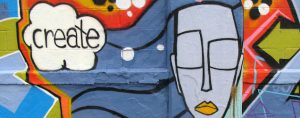4 How do I Transition to Open Pedagogy?
Transforming Disposable Assignments into Renewable Assignments

Attribution: “Create” by Eden, Janine and Jim is licensed under CC BY 2.0
From Disposable to Renewal
Disposable is: a term paper, a final exam, a research paper, audience of one (faculty member) or a class presentation
- Once it is submitted, the value ends
- Students may struggle with academic integrity
- Created for an audience of one
Renewable is: a case study, a chapter in a textbook, a zine, any kind of resource or material that may then be shared with the larger community
- This material/artifact is alive: may be edited the next semester, may be shared with the community, may be revised or remixed by other students around the world
- Students are empowered to decide how others will cite their work
- Openly licensed
How Do You Transition an Assignment from Disposable to Renewable in Real Time?
It may not be as large a leap conceptually for students as you think:
- Students familiar with social media influencers as content creators and ethical attribution:
- familiar with remixing, reusing, renewing and revising influencer content
- familiar with ethical use of influencer content, such as influencer Addison Rae’s appropriation of content via TikTok
- Faculty support student understanding of open licensing to guide licensing decisions
Renewable Assignment Design Framework
Step 1
Analyze and identify current assignment
Step 2
Consider meaningful OER contributions
Step 3
Select tools and repositories
Step 4
Design intentional negotiations for openness
Step 5
Finalize and reclassify assignment
“Renewable Assignment Design Framework” by Jennifer Van Allen & Stacy Katz is licensed under CC BY-NC 4.0
| Student creates an artifact | The artifact has value beyond supporting its creator’s learning | The artifact is made public | The artifact is openly licensed | |
| Disposable Assignments | X | |||
| Authentic Assignments | X | X | ||
| Constructionist Assignments | X | X | X | |
| Renewable Assignments | X | X | X | X |
Adapted from “Criteria Distinguishing Different Kinds of Assignments” in Defining OER-Enabled Pedagogy by Wiley & Hilton under a CC BY 4.0 license.
The Process of Transitioning from Disposable Assignments to Renewable Assignments:
- What do students need to know in order to complete the assignment?
- Will the outcomes change?
- What repositories/tools/OER content will they use?
- Are students invited to create/remix with this assignment?
- Does it support learning beyond creator?
- Are students invited to draw from publicly available material, such as an open case study?
- Is the source material openly licensed?
- Are students invited to publicly license their new artifacts?
Adapted from “Criteria Distinguishing Different Kinds of Assignments” in Defining OER-Enabled Pedagogy by Wiley & Hilton under a CC BY 4.0 license.
Examples of Open Assignments
Examples adapted from Open Pedagogy Assignments in Ditching the Disposable: A Workshop in Designing Renewable Assignments by Van Allen & Katz under a CC BY 4.0 license.
- Students edit wiki article for a Fundamentals of Marketing course, create/edit annotated bibliography in ENG 1021, create a video of an example speech for ENG 1030, create/edit literature review to serve as a teaching tool in Psych 2050 course.
- Students create learning objects (including videos, PowerPoint slides, and diagrams) to help teach course concepts to others. High achieving learners can take a deeper dive, benefit a wider audience
- Students create case studies

